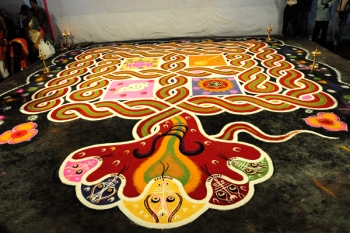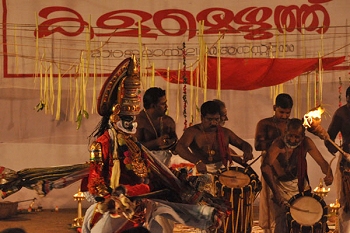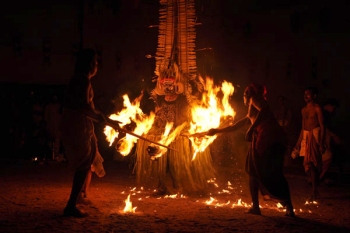
|
 |

|
 |
Kalamezhuthu: A ritual performance - Padma Jayaraj, Thrissur e-mail: padmajayaraj@gmail.com Photos: Murali August 18, 2010 Organized by Lalithakala Academy, the 17-day program, July-Aug 2010, is an attempt to search the roots of the pictorial art of Kerala. Pictorial designs, is the inheritance of humanity from ancient times. All over the world, it first appeared on floors, and on walls of human dwellings. In India, it has existed as part of ritualistic life in Hindu households. Kolam in Tamilnadu, rangoli in Northern India, other forms in different parts of India, are intimately connected with women and their domestic routine. In Kerala, it is in the form of pookkalam, made of flowers during Onam season. A different kind of drawing on the floor, Kalamezhuthu is associated with sacred groves.  Anjanamani Nagakkalam (Photo courtesy: Lalithakala Academy) Kalamezheuthu is a temple-centered ritual, tribal in origin, Dravidian in spirit, tampered with or enhanced by changing times and influences. Naga kalam, Bhagavathy kalam, and kalams dedicated to gods like Vetekaran, Ayyappan etc, trace their origins to groves. This pictorial art, with its inseparable rituals, takes a discerning reader to the roots of the aesthetic sensibilities of cultural Kerala. Kalam progresses through three steps; kalamezhuthu, drawing of the picture, kalam paattu, singing the myth to the accompaniment of instruments, and kalam thullal, enactment of the myth in stylized performance. And it has three aspects - aesthetic, religious, and social. Kalamezhuthu Kalams are combinations of two-dimensional and three dimensional designs drawn on the floor using fine powder culled from nature. The drawing of a kalam starts with a ritual in a space near the temple or the grove. Timed by rituals, it is completed within a specific time. The picture takes shape from a central line. Primary colors, black, white, green, yellow and red are used and drawing is done with hands. The art of shading especially the background, gives a velvet touch. And the border done in circles and squares, in lines and dots, using colors in certain combinations are not just for decoration. Permutations and combinations are used for foregrounding, or to create illusions. The influence of the tantric must be a later addition. The figures drawn come alive when the eyes of the central figures are opened, again at a particular time marked by ritual. And lighted oil lamps around, make the kalam a sacred space where rituals known as thiri uzhichil is a form of worship. Kalam Paattu Songs that illustrate the myth behind the central figure is sung in a sing-song style, to the accompaniment of instruments unique to Kerala, chenda, a drum, conch, and cymbals. Kalam Thullal At the third stage, the deity represented in the kalam is transformed into a persona, kolam. Then on, the myth is enacted in a performance. The mystique of Kalamezhuthu lies in the magical combinations of its designs, loud rhythmic music, stylized movements and masques, amidst the interplay of light in the darkness. For, this ritual performance is a night-long affair, annual events associated with belief systems in primitive communities. Aesthetic aspect  The roots of fine arts unique to Kerala, lie deep in this ritual art. The pictorial designs reveal the roots of the art of drawing: on floor, on face, and on body. They still retain their tribal origin. From here, Kathakali has taken its colors, facial make-up, and costume. The sense of color reveals symbolic meanings influenced by geographical features of tropical terrain and climatic conditions. Night and day in the tropical wild must have shaped the aesthetic sensibilities of Keralites. Growth, decay, and death must have ingrained the philosophical quest. In a kalam, the image becomes a metaphor, and a symbol. Geetham and vadyam is an integral part of Kalamezhuthu. Music unique to Kerala, in accompaniment with chenda, a drum, chiming cymbals, and sounding conch to keep timings add to the surreal as the singer sings the myth connected to the deity. Handed down by tradition, the oral literature known as thottam paattu originated from here. And from these instruments have sprung orchestrations like thayampaka and pancha vadyam, typical Kerala art forms. From the pictorial and the oral, a third stage emerges. The myth is dramatized in a performance, distinctive to Kerala. From the picture, the focus shifts to the performer: the sacred space now becomes the theatre space where stylized performance enacts a deeper reality. And nritta and abhinaya are added to aesthetic aspects. Music, dance, and drama that are unique to Kerala, have sprung from these ritual performances associated with Kalamezhuthu. While percussions exclusive to Kerala created the needed magical ambience, songs and stories gushed from its cornucopias creating poetry. And the theatrical enhanced the dramatic. Koodiyattam, the oldest Sanskrit theatre, had its origin here. Chakyar koothu known for spicy dialogue, rose from here. Stylized dance that became world famous as Kathakali, its facial make-up, its costume, its drama and dance, trace their ancestry to kalams that are still in vogue in many parts of Kerala. Religious aspect  Social aspect Kalams take us back to belief systems that nurtured a society before complexities set in. These were seasonal events that the village looked forward to. In a caste-ridden social hierarchy, each caste played its role in interdependence, created and cemented their beliefs. They even settled matters under divine inspiration of the performer. Lower castes catered to the manifold needs of the upper rungs in the social ladder proving their ability and even superiority, holding the balance of power, an essential political role. Healing facet It had healing aspects too, both psychological and physical. Fear was palpable in primeval communities that lived in the wild. The performer, the mouth piece of god, was a benign force that cured many a psychosomatic illness. The powder made from herbs to draw the kalam could heal common diseases. The grass and leaves with which the costume was made, had properties that attracted and killed germs of contagious diseases. The whole exercise put aside their fears and nurtured their hopes, for, the kalams showcase three needs - protection, production and destruction. Mother goddess appears in various aspects. Naga kalam dedicated to serpents is exclusive to Kerala. They are propitiated even today for fertility and abundance. Protection from the fear of evil and the harmful can also be read in the invocation to the deity. The destruction of enemies, both real and imaginary, happened not as witch hunts but as ritual healing within the parameters of kalams. The weak who suffered definitely got healed. Even when the Academy focused on the pictorial aspects of Kalamezhuthu, the program highlighted the roots of fine arts and aesthetic sensibilities of Kerala, for, what is encoded in the collective unconscious is decoded in these kalams. Retracing the story of our fine arts takes us to kalamezhuthu, kalam paattu and kalam thullal. The fundamentals of popular arts lie buried deep in this folk art, the belief that made the picture and the picture that is central to the belief that created a culture. Padma Jayaraj is a freelance writer and a regular contributor to narthaki.com |